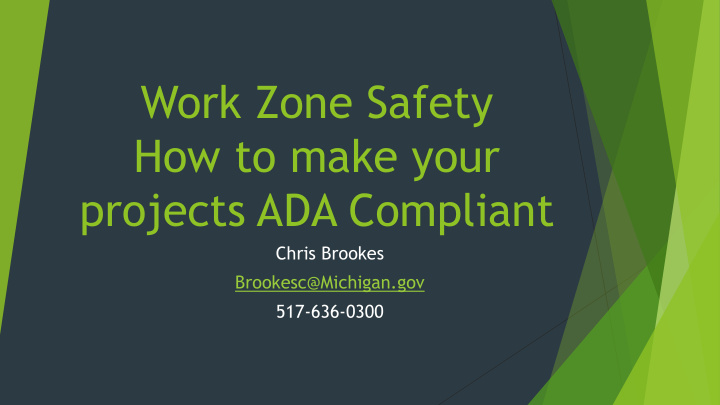



Work Zone Safety How to make your projects ADA Compliant Chris Brookes Brookesc@Michigan.gov 517-636-0300
Lets take a look at the past …. 2003 …. (Before My time at MDOT)
2012-2014 We H ave Improved … A little
Pedestrian ADA 2016 New SP’s are approved and posted on the Web 2012 Previously Approved Division 812 - Temp Traffic Control for Constr Zone Operation Temporary Pedestrian Barrier with Fence-12DS812(J800)-10-30-15 Temporary Pedestrian Type II Barricade-12DS812(J820)-10-30-15 Temporary Pedestrian Type II Channelizer-12DS812(J825)-10-30-15 Division 8 – Incidental Construction Temporary Pedestrian Path-12DS800(J810)-10-30-15 Temporary Pedestrian Ramp-12DS800(J815)-10-30-15 Temporary Pedestrian Passing Space-12DS800(J805)-10-30-15 2012 Templates Division 8 – Incidental Construction Temporary Bus Stop-12TM800(A325)-10-30-15
Temporary Pedestrian Barrier With Fence Use to channelize pedestrians, and provide a high level • of protection. • May be used to separate pedestrian and vehicle traffic. Concrete or water-filled barrier sections are allowed. • Pay Item Pay Unit Pedestrian Barrier with Fence, Temp…………………………….… Foot
Temporary Pedestrian Type II Barricade • Use to close non-motorized facilities in an ADA compliant manner. • Cannot be used to channelize, or separate motorized traffic, or to close motorized facilities. • One barricade is defined as a 4’ section. • Several devices available from different manufacturers. Pay Item Pay Unit Pedestrian Type II Barricade, Temp……………….…………….. Each
ADA Closures
Temporary Pedestrian Type II Channelizer • Use to channelize non-motorized traffic when a high level of protection is not needed. • Cannot be used to separate pedestrians and motorized traffic. • Paid separately from Pedestrian Type II Barricade. • Various devices are available. Pay Item Pay Unit Pedestrian Type II Channelizer, Temp………………..Foot
Temporary Pedestrian Ramp • Used when slopes on temporary paths are greater than 1:12, or to route pedestrians over a vertical obstacle. • Detectable edging and handrails are not always required. • All dimensional constraints spelled out in the Special Provision. Pay Item Pay Unit Pedestrian Ramp, Temp………………………….Each
Temporary Pedestrian Passing Space Constructed as part of a temporary path • • Must be included if the useable width of the path is <60 inches. Located every 200 feet along the path if there is no • break points Pay Item Pay Unit Pedestrian Passing Space, Temp………………………..Each
Temporary Bus Stop • Include in projects when permanent bus stops cannot be accessed due to construction. • Dimensions listed are minimums, size can be increased with demand. • The perimeter must be delineated with a pedestrian channelizing system, paid separately, to separate the bus stop from the work area. • The bus stop may be constructed on a temporary surface or an existing surface. Pay Item Pay Unit Bus Stop, Temporary…………………………..…Each
Temporary Pedestrian Path • Encompasses all temporary pedestrian/non- motorized facility construction. • Minimum width 4 feet. • Cross-slope maximum of 2% • Longitudinal slope maximum of 1:12, anything greater requires a temporary ramp, paid separately. • Suitable materials to construct the path include asphalt materials, Oriented Strand Board (OSB), plywood, dimensional lumber, reclaimed, or other as approved by the Engineer. Compacted soils, aggregate and sand are prohibited. • What is good and what need to be improved in the video? Pay Item Pay Unit Pedestrian Path, Temporary…………………… Foot
Audible Systems
System - Installation
Why do we need to do all the extra work? A basic requirement of work zone traffic control, as provided in the Manual on Uniform Traffic Control Devices (MUTCD), is that the needs of pedestrians, including those with disabilities, must be addressed in temporary traffic control plans (TCPs) in accordance with the Americans with Disabilities Act of 1990 (ADA), Title II, Paragraph 35.130 The law requires pedestrians with physical and/or mental disabilities be accommodated not only in completed publicly accessible facilities, but also during times of construction or improvement. BUT THIS WILL COST MILLIONS! What a waste!!
WHY?
Our Reach Moving Forward Industry Education MDOT is working with traffic control companies and contractors on education and awareness. Meeting with large groups and smaller to answer specific questions MDOT Education Notification of Specification Development Webinars and trainings on how to use the devices Need to make sure the correct items are in the plan Field inspection – what to look for
Recommend
More recommend